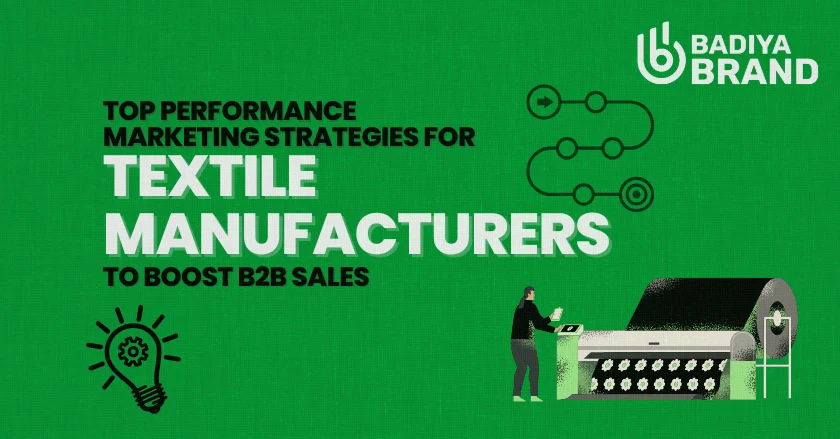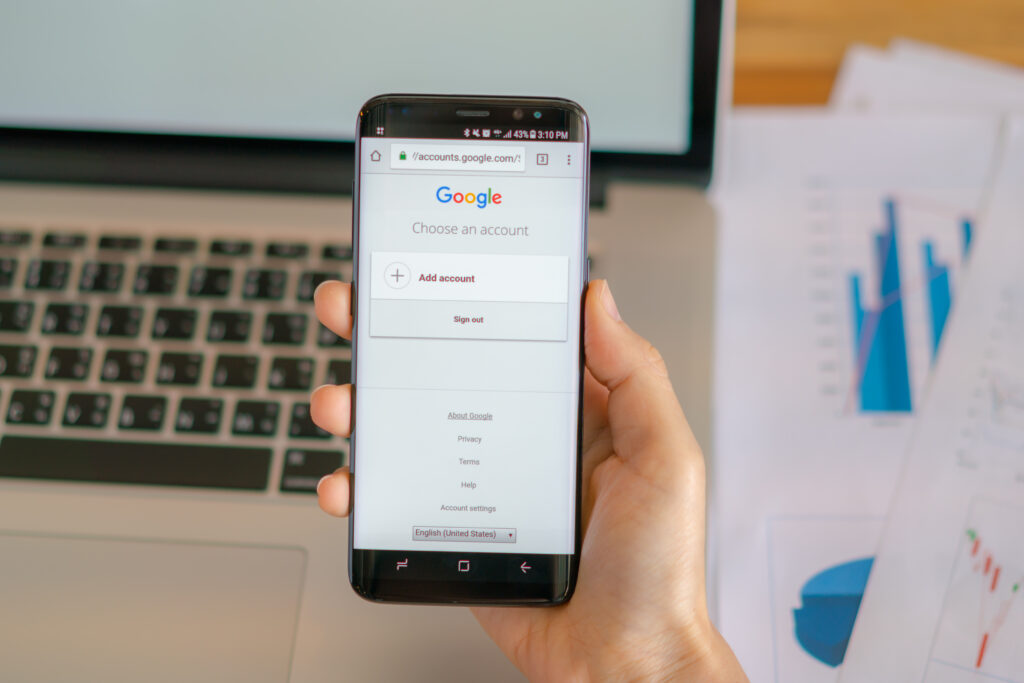
Table of Contents
In the fast-paced world of digital marketing, industrial textile manufacturers are increasingly looking to Performance Marketing Strategies to grow their B2B business. Performance Marketing differs from traditional advertising because it focuses on measurable outcomes – clicks, leads, or sales, making it a powerful marketing capability for manufacturers selling to wholesalers, retailers, or fashion houses. With the growth and evolution of textiles from traditional eCommerce into export marketing, and digital marketing to get your attention e.g. social media, mastering Performance Marketing is critical to your survival and success in 2025+.
Google Ads Performance Marketing Strategies for Textile Manufacturers

One of the most impactful Performance Marketing Strategies for textiles manufacturers is to run targeted Google Ads campaigns using niche-specific keywords. Hence, focus on long-tail keywords that your target customer is likely to search under, such as “bulk cotton fabric suppliers” or “wholesale kurti manufacturers,” which will allow you to attract more B2B traffic with high purchase intent. You could create different ad groups based upon the different types of products you sell such as home textiles, ethnic wear, or industrial fabric.
For best results, make sure that your landing pages are conversion optimized, and address the buyer’s pain points. You will want to watch your ad performance closely and improve your ad performance based on cost per conversion numbers.
Textile Industry Performance Marketing Strategies with LinkedIn Ads

LinkedIn is a treasure trove of B2B-based Performance Marketing Strategies. If you are in a textile business and wish to connect with buyers, sourcing agents, or retail brands, LinkedIn is the place to be. Set up custom campaigns using job titles such as “sourcing manager” or “retail merchandiser”, in countries where you export. Utilizing LinkedIn’s powerful demographic filters, your message will only be delivered to the most relevant leads. You may want to use LinkedIn to promote a downloadable catalog, an invite to a trade show, a bulk quote form, etc.
With efficient targeting and clear call to actions on your ads, LinkedIn campaigns can generate high-quality leads at a competitive Cost Per Lead (CPL).
Performance Marketing Strategies for B2B Leads on Facebook

Facebook isn’t only for B2C, smart textile marketers use it for B2B lead generation by using sophisticated Performance Marketing Strategies. When you upload a list of your top B2B customers, you can create a lookalike audience with people similar to them demographically and behaviorally. Use this with compelling hooks like “Get Wholesale Prices for 2025,” or “Claim Your Free Sample Kit.” You can even include the lead form directly inside Facebook to go even smooth of a conversion. A/B testing on creatives and copy should be done regularly to ensure an ongoing improvement of the results.
Retargeting Strategies for Textile Brands to increase Conversions
Retargeting is one of the least appreciated Performance Marketing Strategies specifically for the textile industry. Many B2B buyers will spend weeks researching before they purchase quarterly quantities. So what do you do to stay up top-of-mind? You retarget, so they can see ads of your brand, products, and services every time they visit another website. Launch display ads on Google, Facebook, and even LinkedIn to retarget these users with relevant messaging — best-selling fabric range or exclusive discount. With firm CTAs, you can retarget warm leads and see an uptick in conversions.
Optimize Your Website and Funnel for Conversion
High-conversion landing pages are crucial to a Great Performance Marketing Strategies. Textile manufacturers must make sure their website loads quickly, is easy to view on mobile and displays their product range in a manner that is easy to see and professional. Make use of strong CTAs – such as “Download Catalog”, “Request a Bulk Quote” or “Schedule a Video Call”. Use heat maps and analytics to track visitor flows and eliminate friction in your funnel. Tools like Google Optimize can be used to test different alternatives for key pages.
High converting websites ensure every click of your ads works harder for your business.
Run Seasonal or Exhibition-Based Campaigns
Clever Performance Marketing works in context to trade show seasons, festivals, or cycles when people are purchasing products. For example you might design campaigns promoting your collection of fabrics for festive wear ahead of Diwali; or run ads ahead of Heimtextil or Textile India inviting buyers to visit your stall or virtual showroom. You might have urgency based CTAs such as “limited appointments available” or “pre-book sampling slots.” The campaigns have time-based value to your campaigns, so your audience’s mind is already processing time.
The urgency around the promotion will not only drive up engagement, but also integrate your performance marketing within the industry’s rhythm in its seasons, while generating a better ROI from leads that come for the time-based aspect.
Automation Strategies That Improve Textile Marketing Performance

Modern Performance Marketing strategies for textile manufacturers increasingly incorporate automation tools such as WhatsApp Business API and email workflows. When a lead hits your funnel via an ad, an automated workflow can signal it to instantly send the lead a catalog link, pricing, or a follow-up cue. This triggers the lead’s journey to remain in a ‘warm’ state with minimal manual labor from you. No code integration tools and platforms like Zapier, Mailchimp, or HubSpot can connect your lead gen forms and your existing communication stack.
By utilizing automation for follow-ups, you decrease the opportunity for no B2B lead opportunity to be lost through consistent follow-ups. On your journey to converting leads in your textile factory business you will only have more valuable leads as your business matures and amplifies your conversion rates.
Collaborate with Influencers in the Textile Trade
Trade not just B2C, industry influencers exist too. Part of your Performance Marketing Strategies could be partnerships with trade influencers, like textile vloggers, industry analysts, or sourcing consultants who have earned trust in your target B2B audience. Ask them to review your factory, showcase your process or highlight your product quality. Sponsored YouTube videos or LinkedIn posts are often hyper-targeted and should lead to some great brand credibility.
Each of these marketing mix elements, extrapolated out further as part of a paid-to-play social media amplification strategy, should help you drive traffic to your B2B website and convert viewers into leads.
Use Conversion-Driven Landing Pages per Product Segment
Textile companies typically deal with several product categories – sarees, suiting-shirting, home linen, etc. One of the smartest Performance Marketing Strategies is to generate separate landing pages for each product category and customize the content, testimonials and calls-to-action, as appropriate for that audience. For example, if I was working on a page for “Wholesale Bed Sheet Suppliers”, I would try to provide bulk price options, logistics information, and production capacity. This will ultimately improve your quality score with Google and your conversion rates.
It is important to monitor your performance using analytics to shift the focus onto the landing pages that are yielding the most leads and develop and grow those pages.
Measure, Optimize, and Scale What Works
Continuous optimization is your last -and most important- Performance Marketing Strategies. Once you have campaign tools for tracking lead flow, such as Google Analytics, Facebook Ads Manager or a CRM tool, monitoring the velocity of your campaign is easy. Examine cost per lead, conversion rate and customer lifetime value to help determine which channels are more profitable than others. You want your “top of funnel” return on investment to be 200-1000% generally. If certain ads are not returning well, pause them. If ads are returning well, spend more on them. Your goal is not lazy marketing.
Performance marketing is also about the constant optimization of getting better and better returns while expending less and less of your company’s money. Performance Marketing is not a one and done plan – it is a process of optimizing every step of the way.
Final Thought
Performance marketing isn’t just a nice-to-have, it’s a must-have for textile manufacturers looking to scale in today’s B2B environment. Whatever the option – from Google Ads to LinkedIn lead generation – the right Performance Marketing Strategies can connect your production house to buyers around the globe. Total transparency, no fluffy metrics – tracking every single rupee of spend – and optimizing every campaign off a real result, will allow your textile company to consistently scale.
Team up with Badiya Brand Digital Marketing Agency where data meets design to deliver performance that sells.
https://badiyabrand.com/performance-marketing/





